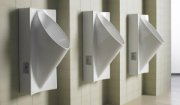Commercial restroom Lighting Fixtures

By Roselena Greiffenstein | April 3,2012 || Architecture and Design | Tags: energy saving ,Sustainable Design
Gradually we have seen how technology has been gaining ground in the bathrooms pubic airports,shopping malls,educational institutions,etc..Increasingly common automatic devices are driven with no human contact through infrared sensors for toilets,sinks and hand dryers.This automated system not only led to significant savings in water and electricity to the facilities,but also promote the sustainability of natural resources and minimizing waste.
But there are many things that still can be improved to optimize the proper use of public toilets.How will they be in the future?In an article published by issatoday.issa.com,Klaus Reichardt,enterprise Waterless Co ,tells us what the trends for public restrooms,always thinking about saving water and electricity,as well as practicality first choice.These are some of the trends that catch our attention:
- Public toilets,particularly in schools,have a coating on the walls chemical resistant graffiti.These materials not only help minimize graffiti marks,but other brands and papers that adhere to the walls allowing them easier to remove.
- Today the use of sunlight is increasing in schools and offices,and it is expected that bathrooms too.For this to be possible,larger windows will be installed,or will be located in strategic places with reflective surfaces that help improve natural lighting.The goal is to reduce the amount of artificial illumination (power) required.Natural light is used in conjunction with occupancy sensors and is expected to more adequate lighting will encourage users to keep bathrooms cleaner and free of graffiti.
- Hot water systems only activated on demand and bathrooms have their own source of hot water.This will help reduce energy needs.
Water saving
No analysis of trends in the bathrooms would be complete without talking about water conservation.In most buildings,the bathroom is where most water is used and wasted.In 1992,the U.S. Congresspassed the Energy Policy Act which mandated that new toilets in the country should not use more than 1.6 gallons of water per flush (GPF).However,at that time as at present,many of them use as many as three or more GPF.
Although the first systems did not work well,as they often required multiple waves for better cleaning,now many manufacturers are introducing toilets that use 1.3 gallons per flush or less.In addition,many facilities are going a step further by using waterless urinals.These are especially popular in educational institutions as they usually do not have handles to drop or external piping,making them less susceptible to vandalism.They also tend to be less expensive to purchase and install a urinal water regardless water savings estimated 40, 000 gallons per year per urinal.
Impact on Cleaning
The bathrooms of the future will be easier to clean and disinfect as they will have fewer contact points and the walls will be fewer victims of graffiti and posters.Thanks to this,the cleaners will spend more of their time and energy where it is needed: in cleaning fixtures and floors.
It is also expected that the procedures and equipment for cleaning floors more automated in both large and small bathrooms.This will be achieved through the use of systems "contactless" and is disregarded cleaning methods and spray cleaner and squeegee systems.Studies indicate that these systems help reduce cleaning time,which in turn can reduce costs.They are considered safer for cleaning worker because you would not need to touch the bathroom accessories. Besides eliminating the need for cleaning floors,where it can spread instead of removing contaminants from soil surfaces.
Are you an female MBA student or a male handyman
Your previous post:
itle: (skilled trade services) Skilled Handyman services: REASONABLE PRICES!!!
DIVERSITY: WM, L.L.C. '2008 ®
Multi-Purpose Mobile Handy Man *Independent Contractor(s)
What We Do?
BIG JOBS- SMALL JOBS, & IN-BETWEEN
Internal & External Painting
Carpentry
Drywall Specialist
Furniture / Appliance Assembly & Repair.
Landscaping
Screener: Pool, Patio, and Porches
Plumbing
Post- Demolition Clean-up
Post-Home Remodeling Clean-up
Household
Repairs/ Remodeling
Tiling
Tile& Parquet Floors
FLOOR TECH:
Strip, Wax, and Buffing
You might also like:



Low-Flow Toilets Required In California For All Home Renovations — Huffington Post
$150,000 CEILING. The new rules give owners of commercial property or multifamily buildings more time and arguably more latitude. They have until 2019 to make sure water-saving toilets, faucets, shower heads and urinals are installed in their properties.


Related posts:
- Copper Bathroom Lighting Fixtures
- Commercial Bathroom Sink Faucets
- Commercial ADA Bathroom Fixtures
- Copper Plumbing fixtures

 Brasilia Casa Cor 2012 Casa Cor Braslia once again brings big names in the region linked to architecture and design for a new sample of 2012. The site is new. Now…
Brasilia Casa Cor 2012 Casa Cor Braslia once again brings big names in the region linked to architecture and design for a new sample of 2012. The site is new. Now… Accessories Page 4: Inspiring Moen Faucets In Times Colonist, Cozy
Accessories Page 4: Inspiring Moen Faucets In Times Colonist, Cozy Our catalogs To make the choice to change your bathroom or opt for boiler, check our online catalogs. A paper version is also available in our showrooms. The water…
Our catalogs To make the choice to change your bathroom or opt for boiler, check our online catalogs. A paper version is also available in our showrooms. The water… Wholesale,complete brass bathroom towel rack,towel rail,towel rack bathroom accessories,$ 65.21/Piece | DHgate DHgate Service Guarantee updated Item Description…
Wholesale,complete brass bathroom towel rack,towel rail,towel rack bathroom accessories,$ 65.21/Piece | DHgate DHgate Service Guarantee updated Item Description… The company Giulio Tanini born in Florence in 1945 and immediately engaged in the supply of materials for construction. During the 1960s, a period of strong economic…
The company Giulio Tanini born in Florence in 1945 and immediately engaged in the supply of materials for construction. During the 1960s, a period of strong economic…
Jan 03, 2010 by CB | Posted in Cleaning & Laundry
I have a 4 month old baby boy and am wondering what are the best products to use?
Full strength 5% white distilled vinegar will kill germs, disinfect against bacteria and deodorize. You can use it in the wash too - 1 cup to a load. It cleans all surfaces and windows. It kills mold also. Adding baking soda to it works as a mild cleanser. Adding baking soda to the wash will soften and deodorize the clothing and lift stains (1/2 cup in the wash). Washing baby clothes with these and Ivory Snow is best for baby thingsand yours too! Baking soda is great for your hair too! For wood Murphy s oil soap and lemon oil. Lemon oil on the kitchen counter makes it clean easily. Magic erasers …
Nov 08, 2008 by Reading and Answering Your Q' | Posted in Respiratory Diseases
Its been there for a few months and I dont have the money to get a professional.
An ounce of prevention is worth of a pound of cure when you need to remove mold from your house. By making it difficult for mold to thrive, you can greatly reduce the incident of mold in your house, and you should remove mold from your house as soon as it starts to show. Do not give mold a chance to gain a foothold, as it can spread spores all over the house, resulting in a moldy nightmare. You should also check closely for signs of mold and mildew in a prospective new house, because they can be difficult to eradicate once established. It can be a challenge to remove mold from your house, but …
Jan 03, 2009 by Lena K | Posted in Cleaning & Laundry
I am wanting to convert my household to be completely free of chemicals and toxins. Including baby products, cleaning and laundry products. I would really love some homemade solutions or even all natural products that are available on the market. Please help. I hope to have converted my house hold within 3 months.
Considering everything is a chemical, it would be somewhat difficult to make your household completely chemical free. Some cleaning products have harsh chemicals because you need strong compounds to kill bacteria. Some good products to use, though, are Seventh Generation products. They re a "green" company, and use non-toxic materials.
Dec 08, 2007 by CAAM | Posted in Cleaning & Laundry
I have read that white vinegar and water is a great way to clean floors. I have two small children at home (one who will eat or put anything in his mouth!), and would just like to stop using so many chemical things. What are some other things I probably already have on hand that are environmentally and child friendly that I can use to clean? I ve heard lemon juice too just not sure what for. And how much would I dilute these household items? Thanks for any suggestions
I ll tell you one item I wish I d known about years ago! Cloth diapers. Not the formed ones, just the plain flat ones. They are cotton, washable, bleachable, lint free, last almost forever and can be used to clean everything As for the cleaner, I simply buy Lysol or Pine Sol in my favorite scent. I keep a spray bottle in my kitchen and bathrooms filled with 1/2 water and 1/2 cleaner. The only other cleaners I use in my entire house are inexpensive furniture oil for wood furniture and Mr. Muscle (the best) oven cleaner for my stovetop around the burners and, of course, the oven, inexpensive …